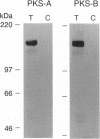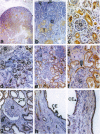Abstract
Polycystic kidney disease 1 (PKD1) is the major locus of the common genetic disorder autosomal dominant polycystic kidney disease. We have studied PKD1 mRNA, with an RNase protection assay, and found widespread expression in adult tissue, with high levels in brain and moderate signal in kidney. Expression of the PKD1 protein, polycystin, was assessed in kidney using monoclonal antibodies to a recombinant protein containing the C terminus of the molecule. In fetal and adult kidney, staining is restricted to epithelial cells. Expression in the developing nephron is most prominent in mature tubules, with lesser staining in Bowman's capsule and the proximal ureteric bud. In the nephrogenic zone, detectable signal was observed in comma- and S-shaped bodies as well as the distal branches of the ureteric bud. By contrast, uninduced mesenchyme and glomerular tufts showed no staining. In later fetal (>20 weeks) and adult kidney, strong staining persists in cortical tubules with moderate staining detected in the loops of Henle and collecting ducts. These results suggest that polycystin's major role is in the maintenance of renal epithelial differentiation and organization from early fetal life. Interestingly, polycystin expression, monitored at the mRNA level and by immunohistochemistry, appears higher in cystic epithelia, indicating that the disease does not result from complete loss of the protein.
Full text
PDF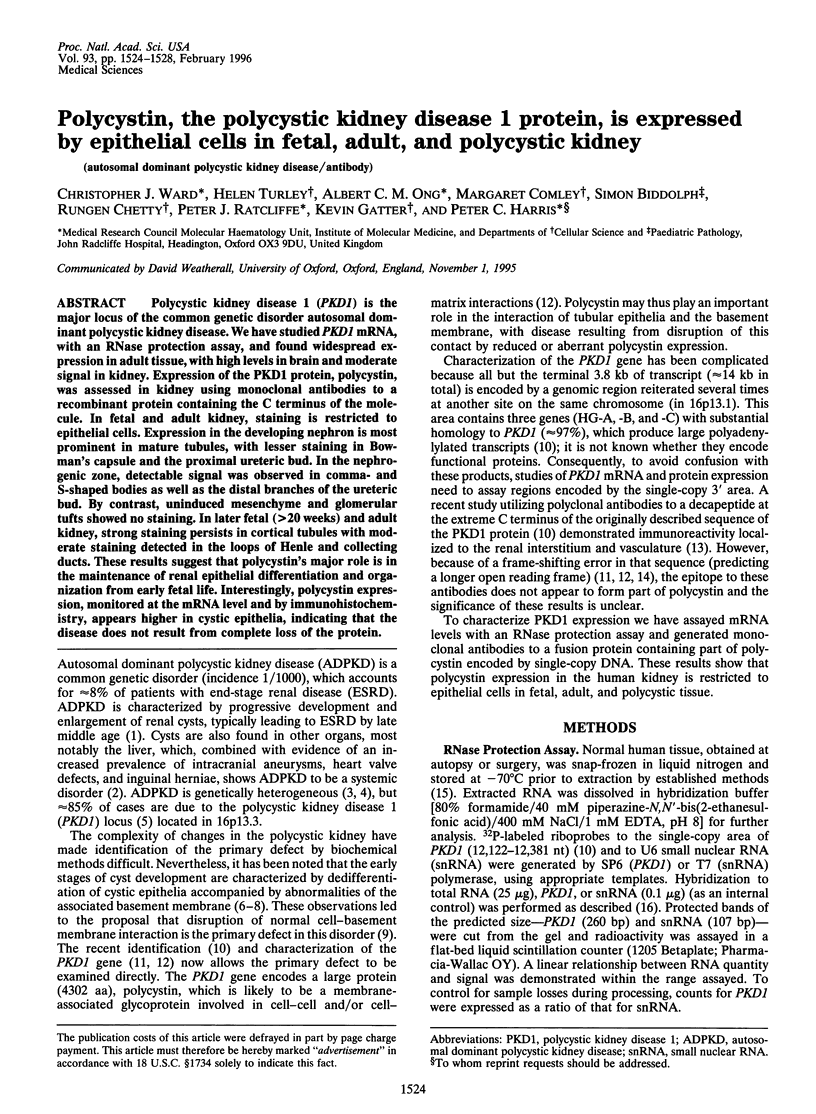
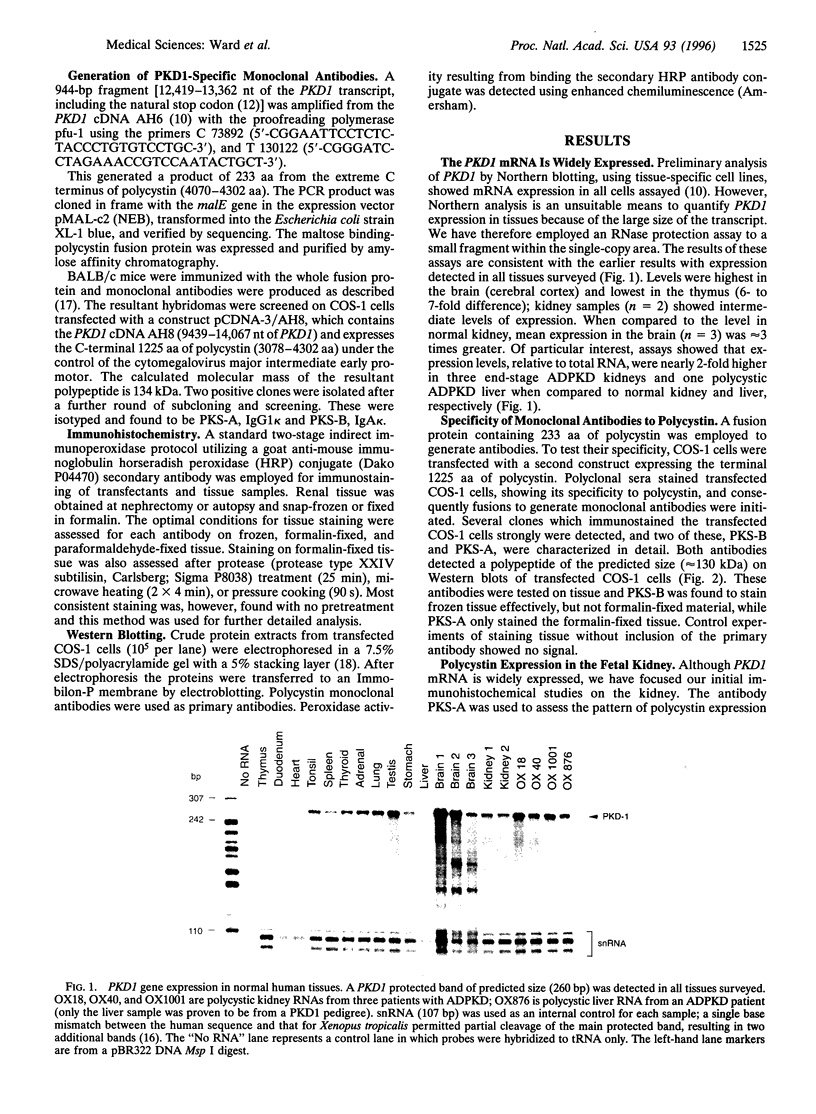
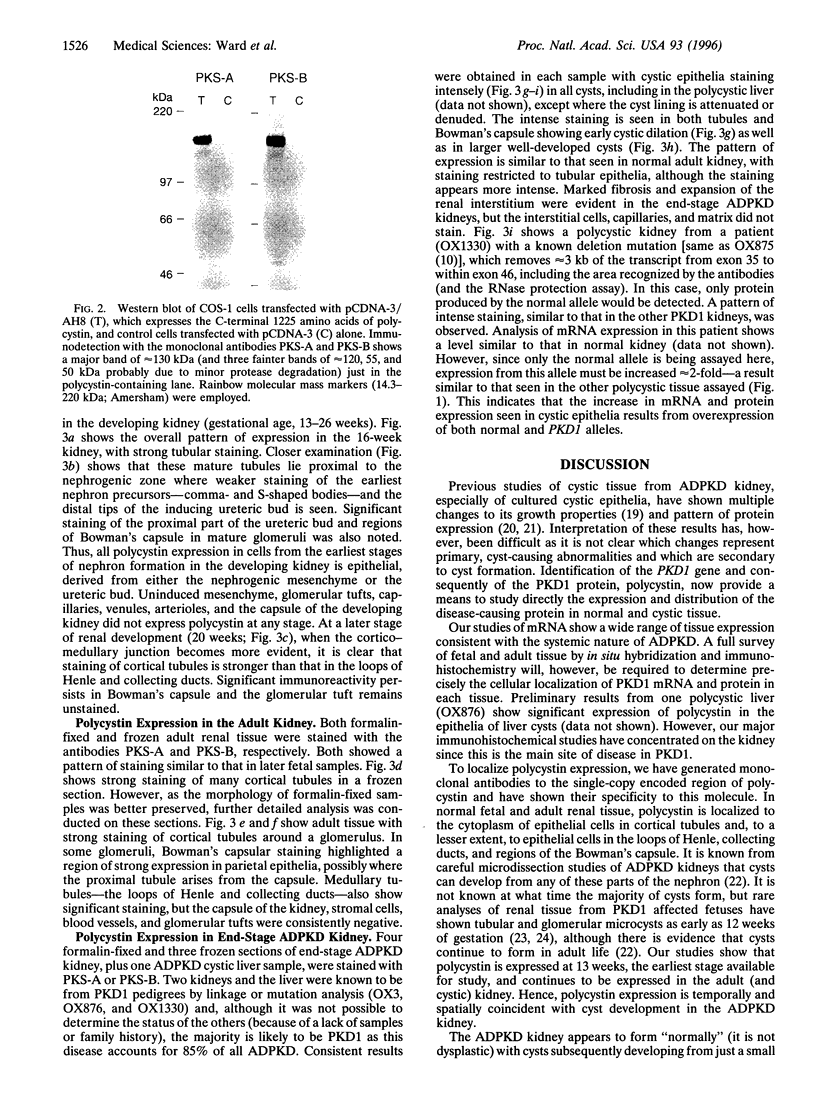
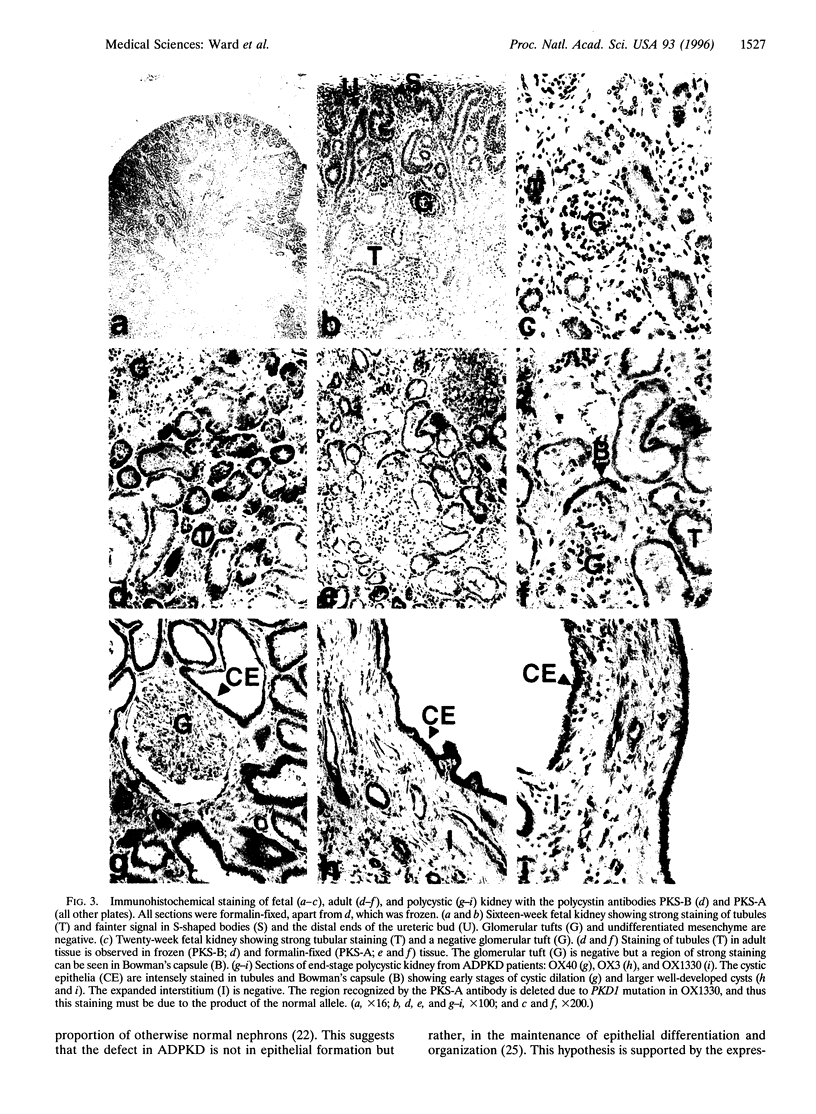
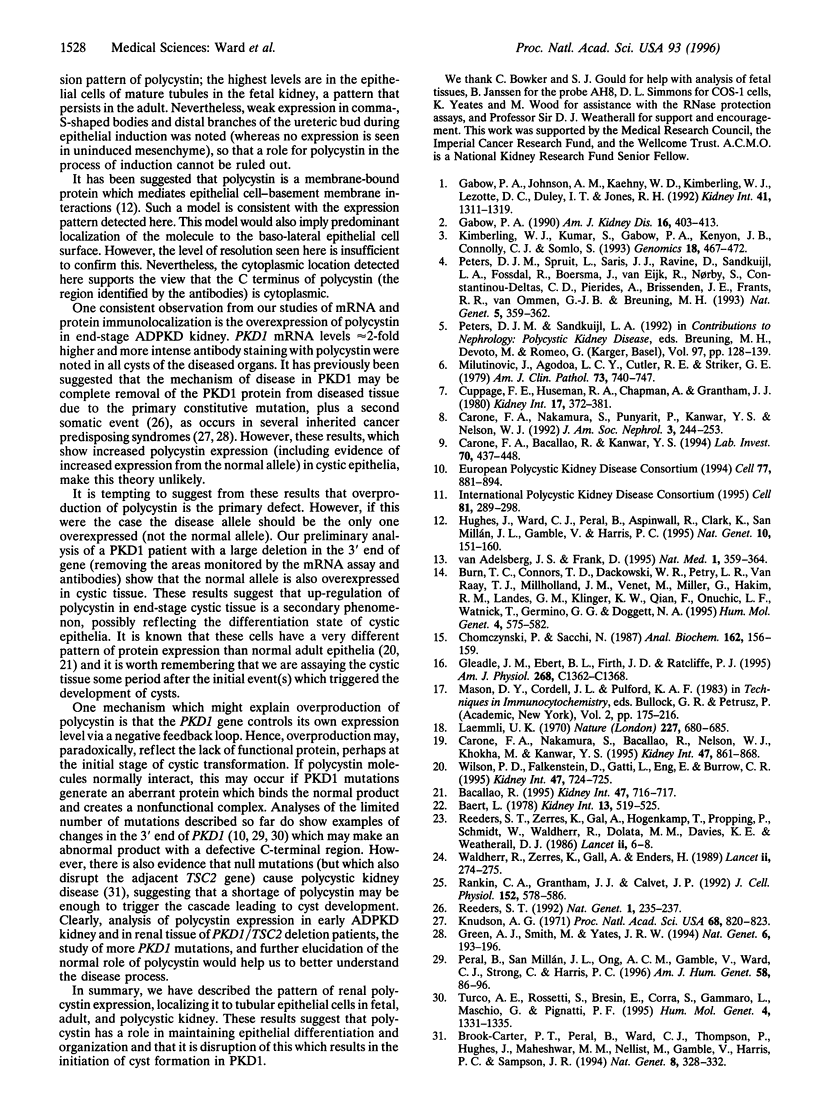
Images in this article
Selected References
These references are in PubMed. This may not be the complete list of references from this article.
- Baert L. Hereditary polycystic kidney disease (adult form): a microdissection study of two cases at an early stage of the disease. Kidney Int. 1978 Jun;13(6):519–525. doi: 10.1038/ki.1978.75. [DOI] [PubMed] [Google Scholar]
- Brook-Carter P. T., Peral B., Ward C. J., Thompson P., Hughes J., Maheshwar M. M., Nellist M., Gamble V., Harris P. C., Sampson J. R. Deletion of the TSC2 and PKD1 genes associated with severe infantile polycystic kidney disease--a contiguous gene syndrome. Nat Genet. 1994 Dec;8(4):328–332. doi: 10.1038/ng1294-328. [DOI] [PubMed] [Google Scholar]
- Burn T. C., Connors T. D., Dackowski W. R., Petry L. R., Van Raay T. J., Millholland J. M., Venet M., Miller G., Hakim R. M., Landes G. M. Analysis of the genomic sequence for the autosomal dominant polycystic kidney disease (PKD1) gene predicts the presence of a leucine-rich repeat. The American PKD1 Consortium (APKD1 Consortium). Hum Mol Genet. 1995 Apr;4(4):575–582. doi: 10.1093/hmg/4.4.575. [DOI] [PubMed] [Google Scholar]
- Carone F. A., Bacallao R., Kanwar Y. S. Biology of polycystic kidney disease. Lab Invest. 1994 Apr;70(4):437–448. [PubMed] [Google Scholar]
- Carone F. A., Nakamura S., Bacallao R., Nelson W. J., Khokha M., Kanwar Y. S. Impaired tubulogenesis of cyst-derived cells from autosomal dominant polycystic kidneys. Kidney Int. 1995 Mar;47(3):861–868. doi: 10.1038/ki.1995.129. [DOI] [PubMed] [Google Scholar]
- Carone F. A., Nakamura S., Punyarit P., Kanwar Y. S., Nelson W. J. Sequential tubular cell and basement membrane changes in polycystic kidney disease. J Am Soc Nephrol. 1992 Aug;3(2):244–253. doi: 10.1681/ASN.V32244. [DOI] [PubMed] [Google Scholar]
- Chomczynski P., Sacchi N. Single-step method of RNA isolation by acid guanidinium thiocyanate-phenol-chloroform extraction. Anal Biochem. 1987 Apr;162(1):156–159. doi: 10.1006/abio.1987.9999. [DOI] [PubMed] [Google Scholar]
- Cuppage F. E., Huseman R. A., Chapman A., Grantham J. J. Ultrastructure and function of cysts from human adult polycystic kidneys. Kidney Int. 1980 Mar;17(3):372–381. doi: 10.1038/ki.1980.43. [DOI] [PubMed] [Google Scholar]
- Gabow P. A. Autosomal dominant polycystic kidney disease--more than a renal disease. Am J Kidney Dis. 1990 Nov;16(5):403–413. doi: 10.1016/s0272-6386(12)80051-5. [DOI] [PubMed] [Google Scholar]
- Gabow P. A., Johnson A. M., Kaehny W. D., Kimberling W. J., Lezotte D. C., Duley I. T., Jones R. H. Factors affecting the progression of renal disease in autosomal-dominant polycystic kidney disease. Kidney Int. 1992 May;41(5):1311–1319. doi: 10.1038/ki.1992.195. [DOI] [PubMed] [Google Scholar]
- Gleadle J. M., Ebert B. L., Firth J. D., Ratcliffe P. J. Regulation of angiogenic growth factor expression by hypoxia, transition metals, and chelating agents. Am J Physiol. 1995 Jun;268(6 Pt 1):C1362–C1368. doi: 10.1152/ajpcell.1995.268.6.C1362. [DOI] [PubMed] [Google Scholar]
- Green A. J., Smith M., Yates J. R. Loss of heterozygosity on chromosome 16p13.3 in hamartomas from tuberous sclerosis patients. Nat Genet. 1994 Feb;6(2):193–196. doi: 10.1038/ng0294-193. [DOI] [PubMed] [Google Scholar]
- Hughes J., Ward C. J., Peral B., Aspinwall R., Clark K., San Millán J. L., Gamble V., Harris P. C. The polycystic kidney disease 1 (PKD1) gene encodes a novel protein with multiple cell recognition domains. Nat Genet. 1995 Jun;10(2):151–160. doi: 10.1038/ng0695-151. [DOI] [PubMed] [Google Scholar]
- Kimberling W. J., Kumar S., Gabow P. A., Kenyon J. B., Connolly C. J., Somlo S. Autosomal dominant polycystic kidney disease: localization of the second gene to chromosome 4q13-q23. Genomics. 1993 Dec;18(3):467–472. doi: 10.1016/s0888-7543(11)80001-7. [DOI] [PubMed] [Google Scholar]
- Knudson A. G., Jr Mutation and cancer: statistical study of retinoblastoma. Proc Natl Acad Sci U S A. 1971 Apr;68(4):820–823. doi: 10.1073/pnas.68.4.820. [DOI] [PMC free article] [PubMed] [Google Scholar]
- Laemmli U. K. Cleavage of structural proteins during the assembly of the head of bacteriophage T4. Nature. 1970 Aug 15;227(5259):680–685. doi: 10.1038/227680a0. [DOI] [PubMed] [Google Scholar]
- Milutinovic J., Agodoa L. C., Cutler R. E., Striker G. E. Autosomal dominant polycystic kidney disease. Early diagnosis and consideration of pathogenesis. Am J Clin Pathol. 1980 Jun;73(6):740–747. doi: 10.1093/ajcp/73.6.740. [DOI] [PubMed] [Google Scholar]
- Peral B., San Millán J. L., Ong A. C., Gamble V., Ward C. J., Strong C., Harris P. C. Screening the 3' region of the polycystic kidney disease 1 (PKD1) gene reveals six novel mutations. Am J Hum Genet. 1996 Jan;58(1):86–96. [PMC free article] [PubMed] [Google Scholar]
- Peters D. J., Sandkuijl L. A. Genetic heterogeneity of polycystic kidney disease in Europe. Contrib Nephrol. 1992;97:128–139. doi: 10.1159/000421651. [DOI] [PubMed] [Google Scholar]
- Peters D. J., Spruit L., Saris J. J., Ravine D., Sandkuijl L. A., Fossdal R., Boersma J., van Eijk R., Nørby S., Constantinou-Deltas C. D. Chromosome 4 localization of a second gene for autosomal dominant polycystic kidney disease. Nat Genet. 1993 Dec;5(4):359–362. doi: 10.1038/ng1293-359. [DOI] [PubMed] [Google Scholar]
- Rankin C. A., Grantham J. J., Calvet J. P. C-fos expression is hypersensitive to serum-stimulation in cultured cystic kidney cells from the C57BL/6J-cpk mouse. J Cell Physiol. 1992 Sep;152(3):578–586. doi: 10.1002/jcp.1041520318. [DOI] [PubMed] [Google Scholar]
- Reeders S. T. Multilocus polycystic disease. Nat Genet. 1992 Jul;1(4):235–237. doi: 10.1038/ng0792-235. [DOI] [PubMed] [Google Scholar]
- Reeders S. T., Zerres K., Gal A., Hogenkamp T., Propping P., Schmidt W., Waldherr R., Dolata M. M., Davies K. E., Weatherall D. J. Prenatal diagnosis of autosomal dominant polycystic kidney disease with a DNA probe. Lancet. 1986 Jul 5;2(8497):6–8. doi: 10.1016/s0140-6736(86)92557-2. [DOI] [PubMed] [Google Scholar]
- Turco A. E., Rossetti S., Bresin E., Corra S., Gammaro L., Maschio G., Pignatti P. F. A novel nonsense mutation in the PKD1 gene (C3817T) is associated with autosomal dominant polycystic kidney disease (ADPKD) in a large three-generation Italian family. Hum Mol Genet. 1995 Aug;4(8):1331–1335. doi: 10.1093/hmg/4.8.1331. [DOI] [PubMed] [Google Scholar]
- Van Adelsberg J. S., Frank D. The PKD1 gene produces a developmentally regulated protein in mesenchyme and vasculature. Nat Med. 1995 Apr;1(4):359–364. doi: 10.1038/nm0495-359. [DOI] [PubMed] [Google Scholar]
- Waldherr R., Zerres K., Gall A., Enders H. Polycystic kidney disease in the fetus. Lancet. 1989 Jul 29;2(8657):274–275. doi: 10.1016/s0140-6736(89)90458-3. [DOI] [PubMed] [Google Scholar]




